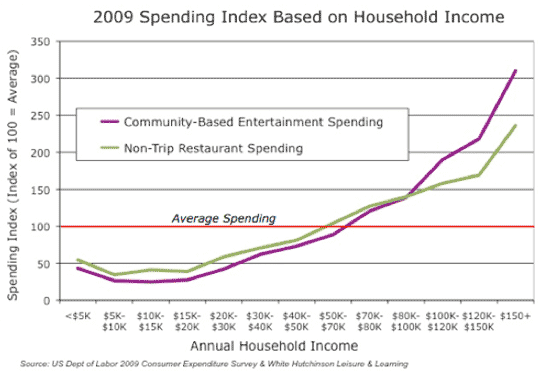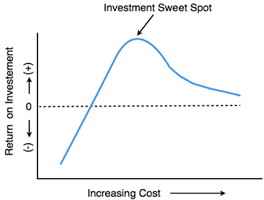Published in RePlay magazine May 2011.
Download a PDF copy of this article by clicking here.
![]()
Target your Market: Why many LBEs have marginal success or failure
by Randy White, CEO
Over our company’s 22-years’ experience in the location-based entertainment (LBE) industry, which includes working on family entertainment centers (FECs), bowling and other community-based entertainment venues, we have been retained by many clients to analyze their poorly performing centers and develop a turnaround strategy to improve performance and profitability. The recent economic downturn has increased that portion of our business, as many facilities that where marginally profitable before the Great Recession now find themselves with reduced sales or financially under water.
For almost all the underperforming LBEs we have examined, the issue of non-existent or minimal profits was primarily attributable to low attendance and low per capita spending. Our analysis of such problem centers has consistently found that for the vast majority, the root cause of the poor performance was due to either or both:
- Lack of focus on a particular market segment
- A mismatch between the center and the socioeconomic-lifestyles in its market
 The focus problem boils down to the owners thinking the road to success in the LBE industry, and especially for FECs, is a broad definition of ‘family’, having a little bit of something for everyone, something for every age group. I remember many of the earlier indoor FECs in the 1990s that said they were targeting families, but included a billiards area. Then the owners wondered why they weren’t attracting as many families as they had hoped. You only had to look at the customers the billiard area attracted to understand why it was a turnoff to moms. I won’t dwell on this issue, as I have written extensively about the need for what we call a focused assortment. The bottom line is that to be successful, you need to shoot with a laser at a narrow market niche rather than shoot at the entire population with a shotgun. You can’t be all things to all people, but you can be very special to a particular market segment. Then, although you didn’t specifically design for them, you will also get secondary markets. This is a basic proven principal of marketing that applies to almost all retail, restaurant and community-based entertainment venues that depend on high repeat business and loyal customers. Just think of all the different women’s dress stores there are and how each brand has a sharp focus on a particular customer segment. Another example is clothing stores such as Abercrombie & Fitch and Buckle that focus on the narrow age range of tweens and teenagers. (This does not necessarily apply to mega stores such as department stores, big box stores or large attractions like theme parks, as they are large enough to offer a broad enough selection for a number of target markets.)
The focus problem boils down to the owners thinking the road to success in the LBE industry, and especially for FECs, is a broad definition of ‘family’, having a little bit of something for everyone, something for every age group. I remember many of the earlier indoor FECs in the 1990s that said they were targeting families, but included a billiards area. Then the owners wondered why they weren’t attracting as many families as they had hoped. You only had to look at the customers the billiard area attracted to understand why it was a turnoff to moms. I won’t dwell on this issue, as I have written extensively about the need for what we call a focused assortment. The bottom line is that to be successful, you need to shoot with a laser at a narrow market niche rather than shoot at the entire population with a shotgun. You can’t be all things to all people, but you can be very special to a particular market segment. Then, although you didn’t specifically design for them, you will also get secondary markets. This is a basic proven principal of marketing that applies to almost all retail, restaurant and community-based entertainment venues that depend on high repeat business and loyal customers. Just think of all the different women’s dress stores there are and how each brand has a sharp focus on a particular customer segment. Another example is clothing stores such as Abercrombie & Fitch and Buckle that focus on the narrow age range of tweens and teenagers. (This does not necessarily apply to mega stores such as department stores, big box stores or large attractions like theme parks, as they are large enough to offer a broad enough selection for a number of target markets.)
 The second root cause is a mismatch with the market areas’ dominant socioeconomic-lifestyles (SELs). This also relates to the need to focus on a particular market niche, but rather than the niche being defined solely by age and type of groups, such as young children, a family with children ages 5-12 or young adults, the niche needs to also be defined by SELs. As much as no one likes to admit it, we humans are class conscious and like to hang out with people like ourselves in terms of our tastes, values and lifestyles. Birds of a feather like to flock together. This is especially true for indoor entertainment venues where dissimilar SELs just don’t mix.
The second root cause is a mismatch with the market areas’ dominant socioeconomic-lifestyles (SELs). This also relates to the need to focus on a particular market niche, but rather than the niche being defined solely by age and type of groups, such as young children, a family with children ages 5-12 or young adults, the niche needs to also be defined by SELs. As much as no one likes to admit it, we humans are class conscious and like to hang out with people like ourselves in terms of our tastes, values and lifestyles. Birds of a feather like to flock together. This is especially true for indoor entertainment venues where dissimilar SELs just don’t mix.
Different socioeconomic-lifestyle groups have different expectations about quality, which in LBEs deals with the quality of everything including the interior design and ambiance, customer service and the quality of the food. Different SELs also respond differently to different pricing levels and different food and beverage selections. Higher SELs are willing to pay a fair price based on value, whereas lower SELs look for the lowest possible price. Heineken beer drinkers come from a different SEL segment than Busch beer drinkers.
Different SELs respond differently to the mix of attractions and entertainment. Our studies have found that certain indoor attractions can skew an FEC’s appeal to lower rather than higher SELs. How the attractions are served up also impacts their SEL appeal. Upscale markets expect upscale presentations.
Where we have found that most LBEs miss the boat on this issue is in failing to design their businesses with the necessary level of quality to attract the upper SEL market, which we will call the upscale market. This upscale market segment contains 32% of all households, yet accounts for almost two-thirds (62%) of all community-based out-of-home entertainment spending and over half (52%) of all non-trip restaurant spending. What those LBEs did was offer Walmarts to markets where the majority of households wanted Targets or even Nordstrom’s (actually I am being kind comparing them to Walmart, as Walmart is professionally designed whereas most of the LBEs were amateur in design).
Targeting and attracting the right SELs for any market area is critical to a LBE’s revenues. Spending on both entertainment and food and beverage varies dramatically based on the socioeconomic-lifestyles of customers. There is a general correlation between socio-economics and spending. The graph below shows the index of spending based on household annual income. An index of 100 is average spending for all households. An index of 200 is twice average spending. An index of 50 is half of average spending. Households with $100,000 to $120,000 incomes spend twice as much at community-based LBEs as households with $50,000-$70,000 incomes and three times as much as $30,000-$40,000 income households. The relationship is just as true for non-trip restaurant spending in the local community.

When it comes to the quality of the business—the physical facility (the ambiance, décor, furniture, or what we call quality-of-place), staff training, menu development and food and beverage presentation, even things like the website and marketing materials—the LBEs failed to make an adequate investment, they under spent. That’s right, their centers didn’t cost enough. This is the opposite of the popularly held belief that you can maximize return-on-investment by spending the least amount of money. Walmarts cost less to build than Targets and Targets cost less than Nordstrom’s. P.F Chang’s China Bistro costs more to build than your local mom and pop Chinese restaurant or a Denny’s. By design or by default, they all attract a particular SEL group.
There is an investment sweet spot, the needed investment to attract a particular SEL group that achieves the maximum return-on-investment. There is a direct relationship between cost and return before the sweet spot is found—the greater the cost (properly spent), the greater the return. Once the sweet spot is reached, the relationship becomes inverse—increasing cost means decreasing return on investment.

The investment sweet spot varies with the particular SEL group the LBE is targeting. The higher you go up the socioeconomic ladder, the greater the investment required to attract them. It takes a much higher level of finish, service and food to please an upscale market. But for that added investment, you achieve the highest attendance, repeat business, highest pricing and highest per capita sales, resulting in higher revenues and profits. Invest too little and they might not show up at all. That is the common problem we see when low investment results in what we call a carnival in a warehouse that is a total turnoff to the higher SELs.
In many of the poorly performing centers we have examined, we traced the cause of the under investment back to the feasibility study, where neither the target market, in terms of age and type of group, nor the socioeconomic-lifestyle segment in that market with the most potential was defined and for it, what was required to attract them. Good feasibility studies deal with much more than numbers. They are about thoroughly analyzing a market and competition, and then defining the best LBE brand identity, mix and the facility and operational characteristics required to create the most successful project.
Success with LBEs deals with much more than just the mix of the entertainment. It deals with the entire emotional experience the guest has based upon their expectations and their need to feel that the LBE reflects who they are and their values and tastes. Only by defining who the guests are that should be targeted, including their SELs, and determining the needed attributes and quality required to attract them can LBEs find the investment sweet spot for maximum success.
Randy White is the CEO of the White Hutchinson Leisure & Learning Group, a multi-disciplinary firm that specializes in feasibility, concept and brand development, design and consulting for leisure and entertainment facilities. Since 1989, the company has worked for over 460 clients in 31 countries. Randy can be reached at +1.816.931-1040, ext 100 or via the company’s Website at www.whitehutchinson.com.


